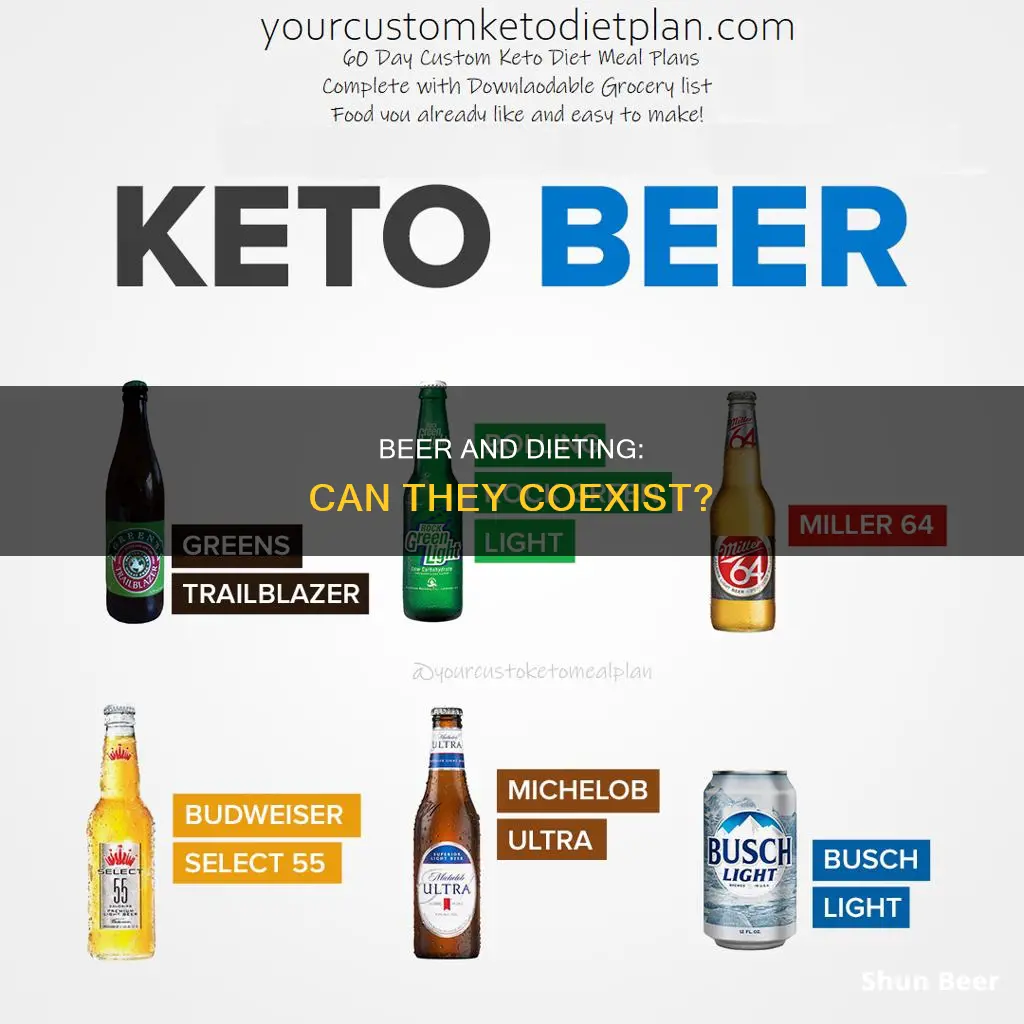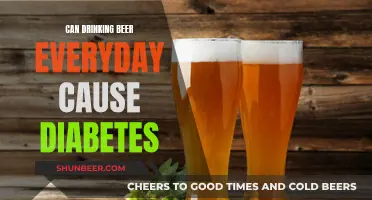
Beer is a popular alcoholic drink, and with various options available, it can be difficult to determine which beers are high or low in calories. Beer can contribute a lot of calories, which can be challenging for those trying to manage their weight. A typical beer contains 150 calories, and if you consume several in one sitting, it can result in a significant calorie overload. Additionally, alcohol can increase your appetite, leading to poor food choices. However, it is possible to enjoy beer in moderation while still losing weight. This involves mindful consumption, such as opting for light beers with 100 calories or less, reducing portion sizes, and drinking less frequently. Ultimately, achieving a caloric deficit is key to weight loss, and this can be accomplished by counting calories and ensuring that the number of calories burned is higher than the number of calories consumed.
| Characteristics | Values |
|---|---|
| Can I still drink beer on a diet? | Yes, but it is harder to create a caloric deficit if you drink every day. |
| How to drink beer and still lose weight? | Drink light or low % ABV beer. |
| Reduce your portion size. | |
| Drink less frequently, such as only on weekends. | |
| If cutting carbs, choose lower-carb beers, like Michelob Ultra, Budweiser Select 55, and Corona Premier. | |
| How to avoid weight gain while drinking beer? | Avoid eating high-fat or high-calorie foods while drinking beer. |
| Alternate every alcoholic drink with a glass of water. | |
| Eat a healthy dinner full of lean protein and good fats before drinking. | |
| Avoid binge drinking. |
What You'll Learn

Beer and weight loss: friends or foes?
Beer and weight loss can coexist, but it is challenging. Beer contributes a lot of calories, which can hinder weight loss and even lead to weight gain. However, with mindful consumption and a few simple strategies, it is possible to enjoy a cold beer while still making progress towards your weight loss goals.
Calories in Beer
Beer contains a significant number of calories, with a typical beer containing about 150 calories per 12-ounce (355 mL) glass. The higher the alcohol content, usually indicated by a higher ABV (alcohol by volume), the higher the calorie count. For example, a regular Budweiser has about 40% more calories than its light version. Craft beers and microbrews can have even higher calorie counts, with some ranging from 170 to 350 calories per 12-ounce serving.
Impact on Weight Loss
When trying to lose weight, it is essential to understand that alcohol provides a quicker and more accessible form of energy for the body than fat. As a result, your body will prioritize burning alcohol over burning fat reserves. Additionally, alcohol can increase your appetite, leading to poor food choices and excess calorie intake. Beer is often accompanied by fatty foods like pizza, wings, and fried snacks, further contributing to calorie overload.
Strategies for Enjoying Beer While Losing Weight
If you want to enjoy a beer without sabotaging your weight loss journey, moderation and mindful consumption are key. Here are some strategies to help you achieve a healthy balance:
- Drink in moderation: Health experts recommend drinking in moderation, which means no more than one drink per day for women and no more than two drinks per day for men. You may need to drink less than this to align with your weight loss goals.
- Choose lower-calorie options: Opt for light beers or beers with lower ABV, as they tend to have fewer calories. Some examples include Bud Light (110 calories), Guinness Draught (125 calories), and Budweiser Select 55.
- Reduce portion sizes: Use smaller glasses or choose cans instead of bottles. A standard drink is 12 ounces (355 mL) of beer.
- Drink less frequently: Consider drinking only on weekends or special occasions.
- Alternate with non-alcoholic beverages: Drink water or low-calorie soda between alcoholic drinks to stay hydrated and reduce your overall alcohol consumption.
- Eat a healthy meal first: Have a nutritious meal before drinking to help slow down alcohol absorption and reduce the temptation to binge on unhealthy bar food.
- Be mindful of your overall calorie intake: Ensure that you are not exceeding your daily calorie budget by accounting for the calories from beer. If needed, cut back on other sources of calories or increase your physical activity to maintain a calorie deficit.
While beer and weight loss can coexist, it requires discipline and moderation. By being mindful of the calories in beer and implementing the strategies outlined above, you can enjoy a beer without derailing your weight loss journey. Remember, the key to successful weight loss is creating a sustainable calorie deficit, so find a balance that works for you and your lifestyle.
Beer and Pfizer: What's the Safe Verdict?
You may want to see also

Counting calories
Beer can be incorporated into a weight-loss plan, but it is challenging due to its calorie content. Beer is primarily composed of water, but it also contains calories from alcohol and carbohydrates. The higher the alcohol content, the higher the calories, and craft beers tend to be higher in alcohol content than lighter beers. Therefore, opting for low-alcohol or alcohol-free beers will usually reduce the calorie count.
To reduce calorie intake while drinking beer, one can employ several strategies:
- Drink less beer overall.
- Drink beer slowly to savour it and stretch one beer over a longer period.
- Opt for low-alcohol or alcohol-free beers.
- Choose lower-carb beers.
- Drink from smaller glasses or opt for cans/bottles with smaller volumes.
- Drink less frequently, such as only on weekends.
- Drink a glass of water between each beer.
- Eat a healthy meal or snack before drinking to help slow alcohol absorption and make better food choices.
It is important to note that drinking alcohol may lead to poorer food choices and increased calorie intake. Therefore, it is recommended to plan drinking into your daily calorie count and be mindful of how drinking affects your eating habits.
How Sales Jobs Can Be Your Dream Career
You may want to see also

Choosing low-calorie beers
If you're looking to cut down on calories but don't want to give up beer, there are a few things to keep in mind. Firstly, it's important to understand that beer can contribute a lot of calories, especially if you're drinking every day, and it can be difficult to determine the exact calorie content of certain beers due to a lack of mandatory labelling. However, there are still ways to enjoy a cold one while watching your weight.
When choosing a low-calorie beer, look for options with a lower alcohol by volume (ABV) percentage. The higher the ABV, the higher the calories. Light beers or low-percentage ABV beers generally have fewer calories. For example, Budweiser and Bud Light have a significant difference in calorie content, with the regular version containing about 40% more calories than the light version.
In addition to choosing lower-ABV beers, you can also reduce your portion size by opting for a smaller glass or a 12-ounce can instead of a 16-ounce bottle. Drinking less frequently, such as only on weekends, can also help cut down on your overall calorie intake.
- Le Petit Prince (2.9% ABV, 75 calories)
- Dogfish Head Slightly Mighty (4% ABV, 95 calories)
- Lagunitas DayTime (4% ABV, 98 calories)
- Budweiser Select (2.4% ABV, 55 calories)
- Molson Ultra (3% ABV, 70 calories)
- Yuengling Light Lager (3.8% ABV, 99 calories)
- Coors Light (4.2% ABV, 102 calories)
- Amstel Light (4% ABV, 95 calories)
- Miller Lite (4.2% ABV, 96 calories)
- Heineken Light (4.2% ABV, 97 calories)
- Corona Light (3.7% ABV, 99 calories)
- Guinness Draught Stout (ABV and calories unknown, described as low-calorie)
Remember, even when choosing low-calorie beers, it's important to drink in moderation and be mindful of your overall calorie intake and nutrition.
Pregnancy and Root Beer: Is Caffeine-Free Safe?
You may want to see also

Drinking less frequently
- Set a drinking limit: Before you go out, decide on a drink limit and stick to it. Having a strong intention, such as only having one or two drinks, will help you stay on track.
- Choose healthier drink options: Opt for lower-calorie drinks such as light beers with less than 100 calories, clear spirits with soda water, or a glass of wine.
- Hydrate: Alternating alcoholic drinks with water will help you cut back. Drinking water in between alcoholic drinks will also help you feel fuller, reducing the urge to drink more.
- Eat a healthy meal first: Having a nutritious meal before drinking will help slow down alcohol absorption and may curb unhealthy food cravings later.
- Exercise: Engage in physical activities such as running, swimming, cycling, or tennis, which are great for reducing body fat.
- Plan ahead: If you know you have a big night out, schedule a workout for the next morning. This will motivate you to drink in moderation.
- Avoid high-calorie foods: When drinking, avoid fatty and high-calorie snacks, as they provide excess energy that your body will store as fat.
- Be mindful: Understand how drinking affects your eating habits and food choices. Be aware of the number and type of drinks you choose.
By following these tips, you can enjoy a beer while also maintaining a healthy lifestyle and working towards your weight loss goals.
Beer and Melatonin: A Safe Mix?
You may want to see also

Eating before drinking
When there is food in your stomach, alcohol is absorbed more slowly. This is because the small intestine, where most alcohol absorption occurs, is slowed down when there is food present. Eating before drinking can therefore reduce the intensity of alcohol's side effects and help you maintain better coordination and thinking abilities.
Additionally, drinking on an empty stomach can increase your risk of a hangover, as well as more serious conditions like alcohol poisoning. Eating before drinking can help reduce these risks. It is recommended to eat at least an hour before drinking if you plan on consuming more than one drink. Choosing foods that are easy to digest and contain carbohydrates, such as pretzels or bread, can also help settle your stomach.
Drinking alcohol can also affect your eating habits and lead to poor food choices. Eating a healthy meal or snacks before drinking can help you make better food choices throughout the day. Good snack options include fruit, air-popped popcorn, or hummus with veggies.
In summary, eating before drinking alcohol is important for managing alcohol's side effects, maintaining control over your drinking, and reducing the risk of negative consequences such as hangovers or alcohol poisoning. It is recommended to eat a full meal or snacks before drinking, especially those with carbohydrates, to slow down alcohol absorption and give your body more time to process it.
Beer Drinking on Kure Beach: What's Allowed?
You may want to see also
Frequently asked questions
Yes, but it is not recommended, as beer is high in calories and can hinder your weight loss goals. If you do choose to drink beer while dieting, be mindful of the number and type of drinks you consume, and ensure that you are still maintaining a caloric deficit.
Beer is high in calories and can contribute to weight gain. The alcohol in beer also provides a quick and accessible form of energy for your body, which can slow down your body's ability to burn fat. Additionally, drinking alcohol can increase your appetite and lead to poor food choices.
If you want to minimise the impact of beer on your diet, consider the following:
- Drink light or low-percentage ABV beers.
- Reduce your portion size by using a smaller glass or opting for a 12-ounce can instead of a 16-ounce bottle.
- Drink less frequently, such as only on weekends.
- Choose lower-carb beers.
- Count your calories and ensure you maintain a caloric deficit.
- Drink water or low-calorie beverages between alcoholic drinks.
- Avoid high-fat or high-calorie meals while drinking.
Yes, there are several alternatives to beer that are lower in calories. Some options include:
- Vodka, soda, and lime.
- Tequila over ice with fresh lime juice and a dash of soda.
- Brut champagne.
- Sparkling water with lime (which can be disguised as an alcoholic drink).







